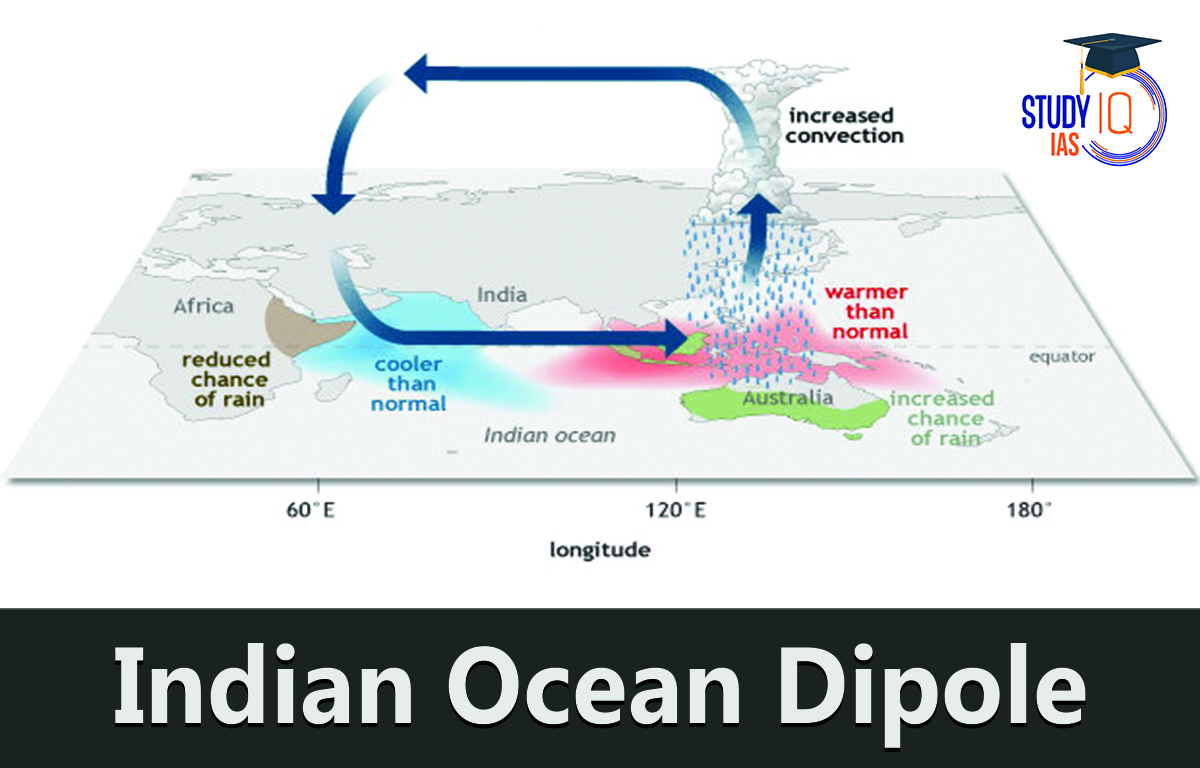Table of Contents
Indian Ocean Dipole
The Indian Ocean Dipole (IOD) is a climate pattern that affects Australia and other countries near the Indian Ocean. It measures the temperature difference between the western Arabian Sea and the eastern area south of Indonesia. The IOD has a big impact on how much it rains in the surrounding Indian Ocean region.
What is Indian Ocean Dipole?
The term “Indian Ocean Dipole” refers to a phenomenon when two poles of the same substance have opposite qualities. As a result, this geographical occurrence takes place in the Indian Ocean and is related to the sea surface temperatures on two of its sides, each of which has a different temperature profile.
The Indian Ocean Dipole (IOD), also called the Indian Nino, is a climate pattern where the western Indian Ocean gets warmer (positive phase) and then cooler (negative phase) compared to the eastern side. If the western side is warm, the eastern side is cold, and vice versa. This temperature change is similar to the El Nino and La Nina events in the Pacific Ocean.
Indian Ocean Dipole Mechanism
The Indian Ocean, the warmest ocean on Earth, is bordered by land on three sides. Tropical easterlies affect the water coming from the Pacific Ocean into the Indonesian Ocean near Australia and Indonesia. These winds blow from the northeast in the northern hemisphere to the southeast in the southern hemisphere, found between 0 and 30 degrees latitude. The Indian Ocean is cut off from the Arctic seas by the Eurasian landmass to the north.
When Pacific Ocean water mixes with Indian Ocean water, it changes the temperature of the Indian Ocean, leading to different phases of the Indian Ocean Dipole (IOD). Here’s how the surface water temperatures vary:
- Neutral Indian Ocean Dipole
- Positive Indian Ocean Dipole
- Negative Indian Ocean Dipole
Neutral Indian Ocean Dipole
- The Neutral Indian Ocean Dipole phase starts in spring when the sun’s rays are evenly spread in both hemispheres.
- This causes easterly winds to flow between 0 and 30 degrees north and south of the equator.
- These easterly or trade winds affect the ocean’s surface temperature.
- During this phase, warm water from the Pacific Ocean mixes with Indian Ocean water.
- As a result, temperatures are uniform in both the eastern and western Indian Oceans.
- This phase is called the Neutral Period of the Indian Ocean Dipole (IOD).
Positive Indian Ocean Dipole
- During this period, westerly winds above the equator weaken. This allows warm water to flow towards Africa.
- Changes in the winds also bring cold water up from the deep ocean to the east.
- This leads to temperature differences in the tropical Indian Ocean: the east becomes colder, while the west becomes warmer.
- This situation is believed to benefit the monsoon.
- It results in a positive dipole in the Indian Ocean.
Negative Indian Ocean Dipole
- During this phase, westerly winds along the equator become stronger.
- Warmer water moves towards Australia.
- This creates temperature differences in the tropical Indian Ocean: warmer water in the east and cooler water in the west.
- This phenomenon can slow down the monsoon’s progress in India.
Indian Ocean Dipole Effects on Indian Monsoon
According to studies, central India receives more rain than typical in an IOD year. It has been demonstrated that in different ENSO years, such as 1983, 1994, and 1997, a high IOD index typically cancels out the influence of ENSO, increasing monsoon rainfall. The eastern part of the Indian Ocean Dipole (IOD) near Indonesia and the western part off the coast of Africa both affect rainfall in the Indian subcontinent during the monsoon. Each pole has its own impact, but they also combine to influence the overall rain.
There is a connection between below-normal SST in the eastern Indian Ocean and higher-than-normal rainfall in the centre of India. On the other side, a negative IOD causes a severe drought when it interacts with El Nino. The Arabian Sea has more cyclones than usual as a result of Positive IOD. Negative IOD results in stronger than usual cyclogenesis (the production of tropical storms) in the Bay of Bengal. In the Arabian Sea, cyclogenesis is lessened during this period. The IOD and Monsoon phenomenon, however, has an oddity.
Indian Ocean Dipole Impacts on India
- Strong IOD effects in 1997 and 1998 caused very heavy monsoons in the Indian subcontinent due to a large positive IOD.
- A similar situation happened in 2006, with about 12 positive IODs recorded since 1980 and only one significant negative IOD in 2010.
- Frequent positive IODs are unusual and concerning because they contributed to the Black Saturday bushfires.
- A notable event occurred in 2007 when a positive IOD combined with La Nina, which had only happened once before in 1967.
- Severe flooding in Queensland (2010–2011) and Victoria (2011) was caused by a strong negative IOD and a strong La Nina, and such patterns of positive IODs are expected to occur at least twice every 1,000 years.
Other Indian Geography Topics
Other Fundamental Geography Topics


 Story of Meera Bai and Her Devotion For ...
Story of Meera Bai and Her Devotion For ...
 Desert Climate, Distribution, Climatic C...
Desert Climate, Distribution, Climatic C...
 Deserts of India Map, Features of Thar D...
Deserts of India Map, Features of Thar D...





















